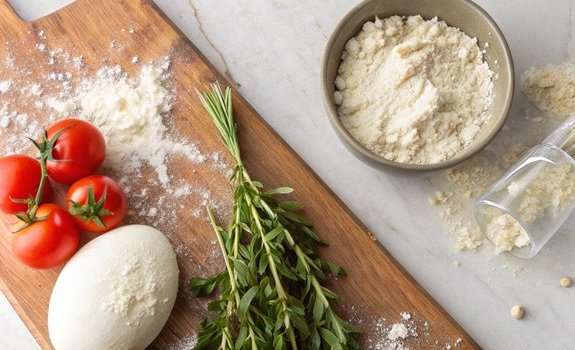Pizza Dough Recipe for 1 Pizza
When you’re in the mood for a homemade pizza, having the right dough recipe can make all the difference. You’ll find that making pizza dough for one pizza is straightforward, requiring just a few simple ingredients and minimal time. As you combine warm water with yeast and sugar, you’ll set the stage for a delicious crust. But what happens next might surprise you—there’s an essential step that can elevate your pizza to a whole new level, and it all revolves around how you handle that dough. Let’s explore this further.
Why You’ll Love This Recipe
You’ll absolutely love this pizza dough recipe for its simplicity and incredible flavor. The ingredients are basic: flour, water, salt, and yeast. This means you won’t need to hunt for fancy items at the store.
Plus, if you’re short on time, you can choose a no-knead method that makes preparation even easier.
One of the best parts is that you can store the dough in the fridge for up to five days or freeze it for three months. This flexibility lets you plan meals without stress. Shaping the dough into rounds is straightforward, making it perfect for your pizza night.
When it comes to baking, you’ll find that it takes only 15 to 20 minutes, so you won’t be waiting long for your delicious pizza.
The cold fermentation process enhances the dough’s flavor and texture, resulting in a chewy, light crust that’s rich in taste. This method also makes the dough easier to digest and increases certain nutrients, which supports enhanced nutritional value.
History
Pizza dough has a rich history that traces back to ancient Mediterranean cultures, where flatbreads served as the earliest bases for pizza-like dishes. These flatbreads, made primarily from flour and water, were seasoned with herbs and baked on hot stones.
Civilizations like the Greeks, Egyptians, and Romans enjoyed these simple creations, which were often considered peasant food. Archaeological evidence from Pompeii supports the existence of pizza-like meals during that time.
In the late 18th century, pizza underwent significant development in Naples, Italy. It was during this period that classic pizza dough took shape, thanks to the influence of Queen Margherita and King Umberto I, who popularized pizza in the 1800s. Quality ingredients such as dry active yeast and flour were essential in creating the ideal dough.
The royal chefs created unique pizzas, elevating the dish’s status and helping Naples become a pizza hub.
As the 19th century progressed, innovations in pizza manufacturing and a variety of toppings emerged. Street vendors sold pizza, making it widely accessible.
Italian immigrants later introduced this delicious dish to America, leading to the establishment of early pizzerias in cities like New York and Chicago.
Today, pizza continues to evolve, reflecting its rich and diverse history.
Recipe

Making homemade pizza dough is a rewarding experience that allows you to customize your pizza exactly how you like it. The key to a great dough lies in using fresh ingredients and allowing the yeast to properly proof. This recipe provides a simple yet effective method for creating a delicious pizza crust that can be topped with your favorite sauces, cheeses, and vegetables. This dough recipe is popular among families and has been frequently recommended for pizza nights.
With a little patience and practice, you’ll be able to impress your family and friends with your homemade pizza creations.
To start, gather your ingredients and prepare your workspace. You’ll need to allow some time for the dough to rise, so plan accordingly. This recipe can be adjusted for single servings or larger batches, and you can experiment with different types of flour or sweeteners as desired.
Follow these instructions carefully to guarantee a successful outcome.
Ingredients:
– ¾ to 1½ cups warm water
– 1 (¼-ounce) package active dry yeast or 2 packets instant dry yeast
– 2 to 2½ cups all-purpose flour
– 1 to 2 teaspoons sugar
– 1 teaspoon sea or coarse salt
– Extra-virgin olive oil for richness, moisture, and flavor
Cooking Instructions:
- Proof the Yeast: In a small bowl, combine warm water (¾ to 1½ cups), sugar (1 to 2 teaspoons), and yeast. Let the mixture sit for about 5-10 minutes until it becomes foamy. This indicates that the yeast is active.
- Mix the Dough: In a large bowl or stand mixer, combine the flour (2 to 2½ cups) and salt (1 teaspoon). Add the foamy yeast mixture and mix until a sticky dough forms. You can use a dough hook for a stand mixer or mix manually with a spoon.
- Knead the Dough: Turn the dough out onto a lightly floured surface. Knead gently 1 to 2 times until it forms a smooth ball. If using a stand mixer, you can knead with the dough hook for a few minutes.
- Let the Dough Rise: Place the dough in a lightly oiled bowl, cover it with a damp cloth or plastic wrap, and let it rise in a warm, draft-free place until it doubles in size. This usually takes about 1 to 1.5 hours.
- Rest the Dough: After kneading, let the dough rest for about 10 minutes before shaping it into pizza rounds.
- Shape and Bake: Turn the dough out onto a lightly floured surface and shape it into a round or divide it into smaller portions for individual pizzas. Preheat your oven to 500-550 degrees F with a pizza stone inside. Stretch the dough gently into your desired shape, place it on parchment paper or a floured pizza peel, and brush with olive oil.
Add your favorite sauce and toppings, being careful not to overload it. Bake for about 10 minutes, then add more cheese if desired and bake for an additional 2 minutes.
Extra Tips: To achieve a crispy crust, use a pizza stone and avoid overloading your pizza with too many toppings. If you’re making a single serving, adjust the rising time to about 30-60 minutes.
Final Thoughts
After enjoying the process of creating your homemade pizza dough, you’ll find that the rewards are well worth the effort.
Storing your dough properly is key to maintaining its quality. If you plan to use it within two weeks, refrigerate it at a temperature range of 35°F to 40°F (1.7°C to 4.4°C). Make sure to wrap it tightly in plastic wrap or place it in an airtight container to prevent it from drying out. When you’re ready to use it, let it come to room temperature and rise for about an hour. Refrigerated dough remains convenient for quick pizza preparation.
If you want to keep your dough for longer, consider freezing it. Divide the dough into portions and shape them into balls or disks, then wrap each tightly in plastic wrap or place them in airtight freezer bags.
Frozen dough can last up to three months. Remember to label each bag with the date so you can track freshness. Thaw it in the refrigerator for one day or at room temperature for four to eight hours before using.
With these storage methods, you’ll always have fresh pizza dough ready whenever the craving strikes!
FAQ
Frequently, beginners have questions about the pizza dough-making process. To start, you’ll need 1 & 1/2 cups lukewarm water, two packets of instant dry yeast, two teaspoons of granulated sugar, 1/4 cup of olive oil, one teaspoon of coarse salt, and four cups of all-purpose flour.
First, pour the lukewarm water into a large bowl, sprinkle the yeast on top, and let it sit for about five minutes until it becomes foamy. This is similar to the step of combining yeast with warm water in the traditional recipe.
Next, whisk in the sugar, olive oil, and salt. Then, add the flour and stir until a sticky dough forms.
For the first rise, place the dough in a lightly oiled bowl, cover it with plastic wrap, and let it sit in a warm place for about an hour until it doubles in size.
When you’re ready to shape the dough, turn it out onto a floured surface, gently knead it a couple of times, and form it into a round.
To bake it, preheat your oven to 500-550 degrees F, add your toppings, and bake for about 10 minutes for a delicious, crispy crust.

Pizza Dough Recipe for 1 Pizza
Ingredients
- Ingredients:
- - ¾ to 1½ cups warm water
- - 1 ¼-ounce package active dry yeast or 2 packets instant dry yeast
- - 2 to 2½ cups all-purpose flour
- - 1 to 2 teaspoons sugar
- - 1 teaspoon sea or coarse salt
- - Extra-virgin olive oil for richness moisture, and flavor
Instructions
- Cooking Instructions:
- Proof the Yeast: In a small bowl, combine warm water (¾ to 1½ cups), sugar (1 to 2 teaspoons), and yeast. Let the mixture sit for about 5-10 minutes until it becomes foamy. This indicates that the yeast is active.
- Mix the Dough: In a large bowl or stand mixer, combine the flour (2 to 2½ cups) and salt (1 teaspoon). Add the foamy yeast mixture and mix until a sticky dough forms. You can use a dough hook for a stand mixer or mix manually with a spoon.
- Knead the Dough: Turn the dough out onto a lightly floured surface. Knead gently 1 to 2 times until it forms a smooth ball. If using a stand mixer, you can knead with the dough hook for a few minutes.
- Let the Dough Rise: Place the dough in a lightly oiled bowl, cover it with a damp cloth or plastic wrap, and let it rise in a warm, draft-free place until it doubles in size. This usually takes about 1 to 1.5 hours.
- Rest the Dough: After kneading, let the dough rest for about 10 minutes before shaping it into pizza rounds.
- Shape and Bake: Turn the dough out onto a lightly floured surface and shape it into a round or divide it into smaller portions for individual pizzas. Preheat your oven to 500-550 degrees F with a pizza stone inside. Stretch the dough gently into your desired shape, place it on parchment paper or a floured pizza peel, and brush with olive oil.
- Add your favorite sauce and toppings, being careful not to overload it. Bake for about 10 minutes, then add more cheese if desired and bake for an additional 2 minutes.
- Extra Tips: To achieve a crispy crust, use a pizza stone and avoid overloading your pizza with too many toppings. If you're making a single serving, adjust the rising time to about 30-60 minutes.



